
There is no national energy policy because there is no public will for one. Sure, blame Congress or President Bush or the oil companies, but we are the problem. We, meaning you, me and others. Part of the reason for our relative insouciance is that life remains okay.
For example, European gasoline prices can be almost triple ours. France is just below $10/gallon, Norway just above and Germany is already up to $11.50. As would be expected, protests are growing. Soon, there could be major demonstrations, if not uncontrolled rioting. You can, of course, move to Venezuela. Simple Solutions for Planet Earth listed gasoline at 12 cents / gallon last year. Today, gasoline still costs 12 cents / gallon there. But do you really want to relocate to that part of the world just for gasoline?
By the way, ten years ago, the price of crude oil was $11.91/barrel, less than one-tenth the cost today. Has something monumental occurred? Ah... yes, although my response should have been more hysterical.
When you come down to it, we have our priorities all wrong, and do nothing about righting this nonsense. For example, each NASA space shot is said to cost about a billion dollars. This is more than the annual Department of Energy renewable energy budget.
Each B-2 Stealth bomber sells for one billion dollars... no, make that $2 billion, including all development costs. A B-2 weighs 2.3 million troy ounces, which, if made of pure gold, would then have a value of, yes, about $2 billion. Of course, it won't fly, but want more?
The U.S. Navy will outlay $160 million/year to man each Nimitz class aircraft carrier, and when the George Bush is christened (no joke, but named for POTUS #41, H.W.) this year, there will be ten of them. The President George W. Bush solar energy budget request is about half what it will cost to operate one nuclear carrier! And we have ten of them... with no major enemy today, and none clearly on the horizon for the next generation or more.
The American public readily accepts this absurdity. Where are the priorities? What can you do about this? You can start by reading those two Simple Solutions books.
The world needs to spend not billions, but trillions, of dollars over the next few years to minimize the crunch of Peak Oil and Global Warming (PO/GW). Nobel Laureate Joseph Stiglitz has a new book entitled, The Three Trillion Dollar War, reporting on the true cost of the Middle East war. The PO/GW 10% solution recommended to POTUS #44 in my May 29th post only provided the global federal government investment. Most of the actual outlay will need to come from industry. But, without the force of law or appropriate spur from government, we have seen that corporations are loath to move into unexplored investment areas, as, for example, sustainable resources, or the remediation of global warming.
So with crude oil settling in the range of $126/barrel (which is exactly $3/gallon), are we now, finally, soon to get a national energy policy? No. Two presidential candidates (John McCain and Hillary Clinton) have actually proposed eliminating the 18.4¢/gallon (24.4¢/gal for diesel) tax during the three summer months to win some votes. Barack Obama said it was a gimmick and Thomas Friedman of The New York Times entitled his editorial: "Dumb as We Wanna Be." Friedman said, in reference to McCain and Clinton, "the unifying idea is so ridiculous, so unworthy of the people aspiring to lead our nation, it takes your breath away."
What's the reality? First of all, if this tax is dropped for the summer, the consumer would be saving 5% -- 5% -- on their gas bill. This should be a non-issue! Gasoline increases this amount each week, sometimes, if not more.
How much money are we talking about? Actually, something in the range of $10 billion. Wow, that's a lot. The U.S. Department of Energy spent less than this amount for renewable energy R&D,cumulative, over the past decade.
Well, Exxon, during this past quarter, made a profit of $10.9 billion, which Wall Street found disappointing. Chevron's profits only amounted to $5.2 billion, the second best quarter in their 132 year history. (How long has oil been around, anyway? Well Chevron first struck oil in California in 1876. Drake drilled for his Pennsylvania petroleum in 1859.) Remember, these profits are only for January, February and March of 2008.
Cutting the gas tax is going in the wrong direction. We need to add a dollar/gallon and apply this revenue to developing sustainable options. That would provide about $150 billion each year, which would be just the complement to the 10% solution suggested in my "Well, Barack, We Have A Problem..." National energy policy? Why bother? A dollar/gallon investment tax on gasoline, the 10% solution and a 10 cents / pound carbon dioxide tax are all we need. Carbon tax? Stay tuned.
Patrick Takahashi is a retired professor of engineering and director emeritus of the Hawaii Natural Energy Institute at the University of Hawaii. He helped draft original legislation on hydrogen, ocean energy and wind power when he worked for the U.S. Senate more than a quarter century ago.